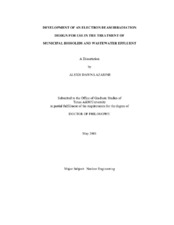| dc.contributor.advisor | Ford, John R | |
| dc.contributor.advisor | Pillai, Suresh D | |
| dc.creator | Lazarine, Alexis Dawn | |
| dc.date.accessioned | 2010-01-15T00:06:47Z | |
| dc.date.accessioned | 2010-01-16T00:56:47Z | |
| dc.date.available | 2010-01-15T00:06:47Z | |
| dc.date.available | 2010-01-16T00:56:47Z | |
| dc.date.created | 2008-05 | |
| dc.date.issued | 2009-05-15 | |
| dc.identifier.uri | https://hdl.handle.net/1969.1/ETD-TAMU-2787 | |
| dc.description.abstract | The need for pathogen-free water supplies has spurred investigations into the use
of ionizing radiation for the treatment of wastewater effluent and municipal biosolids.
The objective of this research was to develop an electron-beam irradiation scenario to
effectively eliminate microbial pathogens from municipal biosolids and wastewater
effluent. The Monte Carlo N-Particle (MCNP5) radiation transport code was used to
simulate the irradiation scenario.
Using MCNP5, dual electron-beam sources were modeled as planar
surface sources above and below a stainless steel delivery trough containing either
effluent water or one of two biosolids material compositions. A dose deposition analysis
was performed to assess both the planar dose distribution and 25 depth-dose curves. In
addition, a density perturbation study was performed to assess the variance in the dose
deposition for different mass solids concentrations. To validate the MCNP5 code for this type of application, a benchmark study was
performed. Two municipal biosolids materials and water were irradiated in plastic bags
on a conveyor belt using a 10-MeV electron accelerator with the exit window below the
material. The experimental configuration was modeled with the MCNP5 radiation
transport code. Simplified and detailed models were created and analyzed.
Lastly, an economic analysis was performed to assess whether this treatment
method is a financially viable alternative to current wastewater treatment methods.
Processing capacity was calculated for two accelerator specifications. These capacity
rates in conjunction with the operating and capital costs per dry ton to irradiate the
material were compared with existing data for electron beam processing of municipal
biosolids. The cost breakdown was also compared with quoted costs for existing
conventional methods.
The models developed showed that the use of 10MeV electron-beam technology
for the treatment of wastewater effluent and municipal biosolids is effective and
economically feasible. The benchmarking study illustrated the accuracy of Monte Carlo
simulation for this type of application. The method development process was shown to
be adaptable for various material compositions and irradiation configurations. | en |
| dc.format.medium | electronic | en |
| dc.format.mimetype | application/pdf | |
| dc.language.iso | en_US | |
| dc.subject | wastewater treatment | en |
| dc.subject | municpal biosolids | en |
| dc.title | Development of an electron beam irradiation design for use in the treatment of municipal biosolids and wastewater effluent | en |
| dc.type | Book | en |
| dc.type | Thesis | en |
| thesis.degree.department | Nuclear Engineering | en |
| thesis.degree.discipline | Nuclear Engineering | en |
| thesis.degree.grantor | Texas A&M University | en |
| thesis.degree.name | Doctor of Philosophy | en |
| thesis.degree.level | Doctoral | en |
| dc.contributor.committeeMember | Braby, Leslie A | |
| dc.contributor.committeeMember | Poston, John W | |
| dc.type.genre | Electronic Dissertation | en |
| dc.type.material | text | en |
| dc.format.digitalOrigin | born digital | en |


